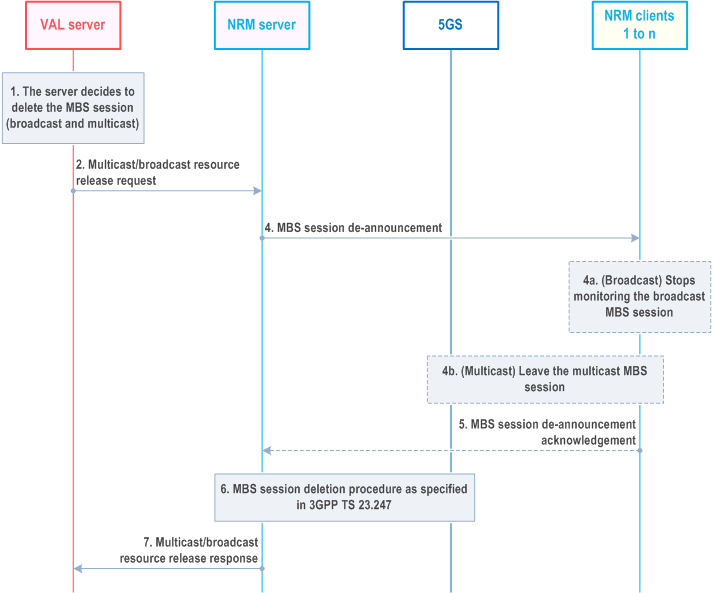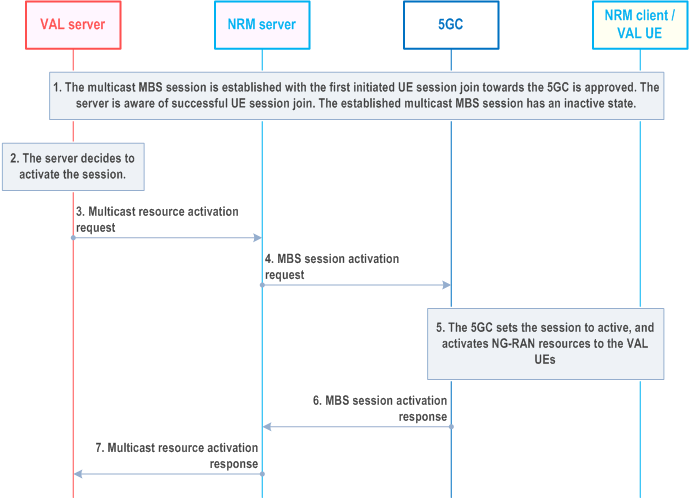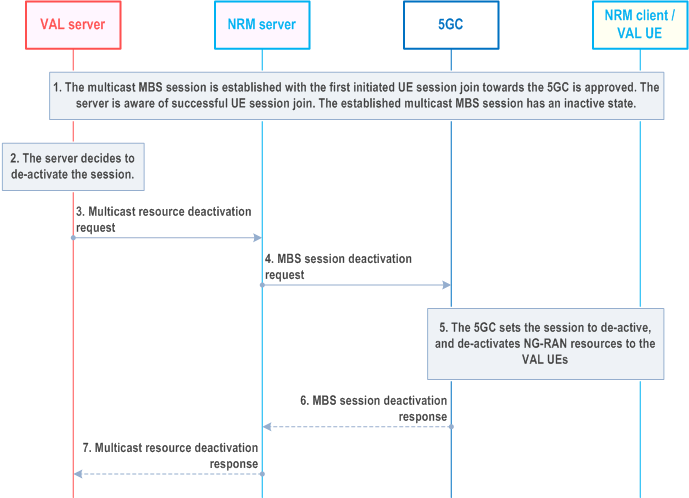Content for TS 23.434 Word version: 19.3.0
0…
4…
5
6…
6.4…
6.5…
6.5.3…
7…
8…
8.2.2…
9…
9.3…
9.3.2.21…
9.3.3…
9.3.6…
9.3.11…
9.3.13…
9.3.14…
9.4…
9.4.6…
9.5…
10…
10.3…
10.3.2.22…
10.3.3…
10.3.7…
10.3.10…
10.4…
11…
11.3…
11.3.3…
11.4…
12…
12.3…
13…
14…
14.2.2.2…
14.3…
14.3.2.20…
14.3.2.40…
14.3.3…
14.3.3.3…
14.3.4…
14.3.4.6
14.3.4.7…
14.3.4A…
14.3.4A.3…
14.3.4A.4…
14.3.4A.6…
14.3.4A.8…
14.3.4A.9…
14.3.4A.10…
14.3.5…
14.3.6…
14.3.9…
14.3.12…
14.4…
15…
16…
17…
18…
A
B…
14.3.4A.4 MBS resource deletion
14.3.4A.5 Request to activate / de-activate multicast MBS sessions
14.3.4A.5.1 General
14.3.4A.5.2 Multicast MBS session activation procedure
14.3.4A.5.3 Multicast MBS session de-activation procedure
...
...
14.3.4A.4 MBS resource deletion p. 238
14.3.4A.4.1 General p. 238
The VAL server can decide to release a certain MBS session once it is no longer further utilized for the associated VAL service group communication, e.g., the VAL service group is no longer active, the VAL media transmission is over and no further VAL media to be delivered, group communication is terminated. The MBS session deletion procedure leads to releasing the network resources associated to that MBS session.
To delete the MBS session, the VAL server invokes the multicast/broadcast resource release service of NRM server which further triggers the NRM server to send an MBS session deletion request to the 5GS providing the corresponding MBS session ID. The MBS session deletion request is sent to the MB-SMF (directly or via NEF/MBSF) when PCC is not used. However, if dynamic PCC rule is utilized, a policy authorization deletion request is initially sent to the PCF. Further details of the MBS session deletion are provided in TS 23.247.
NRM server further informs the NRM client with the MBS session de-announcement, so that the VAL UE stops monitoring the broadcast MBS session or leaves the multicast MBS session. This procedure is applied for both broadcast MBS session and multicast MBS session.
14.3.4A.4.2 Procedure p. 238
The procedure in Figure 14.3.4A.4.2-1 describes the MBS session deletion aspects for group communication.
Pre-conditions:
- NRM clients 1 to n are attached to the 5GS, registered and affiliated to the same active VAL service group.
- An MBS session is configured to address the corresponding VAL service group with certain service requirements and optionally with a certain broadcast/multicast service area. The session is announced and established for group communication purposes for the VAL service group.

Step 1.
The VAL server decides to delete the MBS session for the associated VAL group communication, either multicast or broadcast session.
Step 2.
The VAL server invokes the multicast/broadcast resource release service of the NRM server by sending the multicast/broadcast resource release request.
Step 3.
Upon receiving the multicast/broadcast resource release request, the NRM server sends an MBS session de-announcement message with the MBS session ID towards the NRM client(s). Upon receiving the MBS session de-announcement message, either 4a or 4b is performed.
Step 4a.
If the MBS session identified by MBS session ID is a broadcast MBS session, the UE(s) stops monitoring the broadcast MBS session and removes the broadcast MBS session related information.
Step 4b.
If the MBS session identified by MBS session ID is a multicast MBS session, the joined UE(s) initiate an MBS session leave procedure to leave the indicated MBS session in order to release the respective network resources, as defined in TS 23.247.
Step 5.
Subsequently, the NRM clients may send an MBS session de-announcement acknowledgement message to the NRM server indicating the status of MBS session.
Step 6.
The NRM server initiates the MBS session deletion procedure with the 5GC (either directly or through NEF/MBSF) in order to stop using the configured MBS session and release the corresponding network resources. The NRM server indicates within the MBS session release request the corresponding MBS session ID. The MBS session deletion procedure can either be with or without a dynamic PCC rule, as indicated in TS 23.247.
Step 7.
The NRM server returns the multicast/broadcast resource release response to the VAL server indicating the result.
14.3.4A.5 Request to activate / de-activate multicast MBS sessions p. 240
14.3.4A.5.1 General p. 240
In case of multicast MBS sessions, the members affiliated to a certain VAL service group need to initiate a UE session join request towards the 5GC in order to receive the VAL media sent via the associated MBS session. The UE session join request enables the reservation of NG-RAN resources for the members of the VAL group. However, it is not necessary that the VAL media is delivered over the whole time the multicast MBS session is associated to the group under consideration. Therefore, the VAL server is able to efficiently utilize and control the reservation of radio resources based on the availability of VAL data to be delivered via the activation and de-activation procedure with NRM server. This presents more flexibility and efficient use of resources different from LTE.
The most suitable scenario to activate/de-activate a certain multicast MBS session is based on whether there is a VAL group communication, taking place over that associated session to the VAL service group. In this manner, the VAL server can activate the associated multicast session once a VAL group communication takes place, then deactivate it once the VAL group communication is over. Whether the multicast session is activated (i.e., in an active state), or de-activated (in an inactive state), the VAL group is associated to the multicast session and its members are within a UE session join.
The activation or de-activation request is initiated by the VAL server towards the NRM server which further interacts either directly with the MB-SMF or indirectly with NEF/MBSF.
14.3.4A.5.2 Multicast MBS session activation procedure p. 240
The procedure shown in Figure 14.3.4A.5.2-1 presents the multicast MBS session activation procedure initiated by the VAL server.
Pre-conditions:
- NRM clients are attached to the 5GS, registered and affiliated to the same VAL service group X.
- The NRM server has directly performed (or via NEF/MBSF) an MB-SMF discovery and selection, unless the corresponding information is locally configured.
- The multicast MBS session for NRM group communications associated to VAL service group X.
- The MBS session is created and announced to address VAL group communication related to the associated VAL service group X with certain service requirements and optionally with a certain service area.

Step 1.
The multicast MBS session is established as the first UE session join request, which is initiated by the first VAL UE towards 5GC, is granted. At this stage, the multicast MBS session is established with an inactive state.
Step 2.
The VAL server decides to activate the multicast MBS session as VAL data is needed to be transmitted over the session to the VAL service group X, as a VAL group communication is to take place over the associated MBS session.
Step 3.
The VAL server invokes the multicast resource activation request provided by NRM server, the MBS session ID is included.
Step 4.
Upon receiving the request in step 3, the NRM server sends an MBS session activation request towards the 5GC, either directly to the MB-SMF or via NEF/MBSF, indicating the TMGI to be activated.
Step 5.
The 5GC changes the session status to "active" and finds the list of joined VAL UEs associated with the session and activates the NG- RAN resources for VAL data delivery.
Step 6.
The 5GC may send an MBS session activation response to the NRM server indicating that the requested multicast MBS session has been activated.
Step 7.
The NRM server returns the multicast resource activation response to the VAL server.
14.3.4A.5.3 Multicast MBS session de-activation procedure p. 241
The procedure shown in Figure 14.3.4A.5.3-1 presents the multicast MBS session activation procedure initiated by the VAL server.
Pre-conditions:
- NRM clients are attached to the 5GS, registered and affiliated to the same VAL service group X.
- The NRM server has directly performed (or via NEF/MBSF) an MB-SMF discovery and selection, unless the corresponding information is locally configured.
- A multicast MBS session is created and announced to address the corresponding VAL service group with certain service requirements and optionally with a certain multicast service area.
- The VAL UE have already joined the multicast MBS session and are able to receive the VAL data over the associated MBS session.

Step 1.
The group communication associated with VAL service group X takes place, and the corresponding VAL data is delivered over the associated multicast MBS session, hence the MBS session has an active state.
Step 2.
The VAL server decides to deactivate the multicast MBS session, as no further VAL data to be delivered to the associated group, or the VAL group communication is over, and no further VAL media is to be delivered.
Step 3.
The VAL server invokes the multicast resource deactivation request provided by NRM server, the MBS session ID is included.
Step 4.
Upon receiving the request in step 3, the NRM server sends an MBS session deactivation request towards the 5GC, either directly to the MB-SMF or via NEF/MBSF, indicating the TMGI to be deactivated.
Step 5.
The 5GC changes the session state to "inactive" and deactivates the radio resources associated with the joined VAL UEs.
Step 6.
The 5GC may send an MBS deactivation response to the server indicating that the requested multicast MBS session has been inactivated.
Step 7.
The NRM server may return the multicast resource deactivation response to the VAL server.